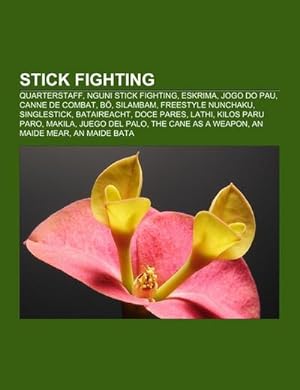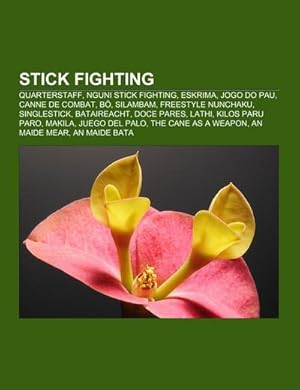9781156014998 (2 risultati)
Tipo di articolo
- Tutti gli articoli
- Libri (2)
- Riviste e Giornali
- Fumetti
- Spartiti
- Arte, Stampe e Poster
- Fotografie
- Mappe
-
Manoscritti e
Collezionismo cartaceo
Condizioni
- Tutte
- Nuovi
- Antichi o usati
Legatura
- Tutte
- Rilegato
- Brossura
Ulteriori caratteristiche
- Prima edizione
- Copia autografata
- Sovraccoperta
- Con foto
- No print on demand
Paese del venditore
Valutazione venditore
-
Stick fighting
Editore: Reference Series Books LLC Okt 2011, 2011
ISBN 10: 1156014999ISBN 13: 9781156014998
Da: BuchWeltWeit Ludwig Meier e.K., Bergisch Gladbach, Germania
Libro Print on Demand
Taschenbuch. Condizione: Neu. This item is printed on demand - it takes 3-4 days longer - Neuware -Source: Wikipedia. Pages: 32. Chapters: Quarterstaff, Nguni stick fighting, Eskrima, Jogo do Pau, Canne de combat, Bo, Silambam, Freestyle nunchaku, Singlestick, Bataireacht, Doce Pares, Lathi, Kilos Paru Paro, Makila, Juego del Palo, The Cane as a Weapon, An Maide Mear, An Maide Bata, Bojutsu, Tahtib, Pierre Vigny, Tambo, Bajan stick licking, Bâton français, Nangun, El Juego del Garrote, Tanjojutsu. Excerpt: Eskrima, Arnis and Kali refer to a class of Filipino martial arts that emphasize weapon-based fighting with sticks, blades and improvised weapons. Although training starts with weapons, empty hand techniques, trapping and limb destruction are core parts of these arts as the weapon is considered merely an extension of the body. Eskrima and Arnis are the most common among the many names often used in the Philippines today to refer to these arts. The teaching of the basic skills in Eskrima are traditionally simplified. With limited time to teach intricate moves, only techniques that were proven effective in battle and could easily be taught en masse were used. This allowed villagers, generally not professional soldiers, a measure of protection against other villages, as well as foreign invaders. This philosophy of simplicity is still used today and is the underlying base of eskrima. Because of this approach, eskrima and the Filipino martial arts in general are often mistakenly considered to be 'simple'. However, this refers only to its systematization, not effectiveness. To the contrary, beyond the basic skills lies a very complex structure and a refined skillset that takes years to master. For the purpose of simplification, Eskrima shall be used to refer to the interchangeable terms of Arnis and Kali for the rest of the article. For all intents and purposes, Eskrima, arnis and kali all refer to the same family of Filipino weapon-based martial arts. In Luzon they may go by the name of arnis, arnis de mano, sinawali, pagkalikali, panandata (usage of weapons), didya, kabaroan (blade usage) and kaliradman. In the Visayas and Mindanao, these martial arts have been referred to as eskrima, kali and kalirongan. Kuntaw and silat are separate martial arts that have been practiced in the islands. Eskrima is a Filipinization of the Spanish word for fencing (esgrima). Arnis comes from arnes, Old Spanish for armor (harness is an archaic English term for armor which comes from the s 32 pp. Englisch.
-
Stick fighting : Quarterstaff, Nguni stick fighting, Eskrima, Jogo do Pau, Canne de combat, Bo, Silambam, Freestyle nunchaku, Singlestick, Bataireacht, Doce Pares, Lathi, Kilos Paru Paro, Makila, Juego del Palo, The Cane as a Weapon, An Maide Mear
Editore: Books LLC, Reference Series
ISBN 10: 1156014999ISBN 13: 9781156014998
Da: AHA-BUCH GmbH, Einbeck, Germania
Libro Print on Demand
Taschenbuch. Condizione: Neu. nach der Bestellung gedruckt Neuware - Printed after ordering - Source: Wikipedia. Pages: 32. Chapters: Quarterstaff, Nguni stick fighting, Eskrima, Jogo do Pau, Canne de combat, Bo, Silambam, Freestyle nunchaku, Singlestick, Bataireacht, Doce Pares, Lathi, Kilos Paru Paro, Makila, Juego del Palo, The Cane as a Weapon, An Maide Mear, An Maide Bata, Bojutsu, Tahtib, Pierre Vigny, Tambo, Bajan stick licking, Bâton français, Nangun, El Juego del Garrote, Tanjojutsu. Excerpt: Eskrima, Arnis and Kali refer to a class of Filipino martial arts that emphasize weapon-based fighting with sticks, blades and improvised weapons. Although training starts with weapons, empty hand techniques, trapping and limb destruction are core parts of these arts as the weapon is considered merely an extension of the body. Eskrima and Arnis are the most common among the many names often used in the Philippines today to refer to these arts. The teaching of the basic skills in Eskrima are traditionally simplified. With limited time to teach intricate moves, only techniques that were proven effective in battle and could easily be taught en masse were used. This allowed villagers, generally not professional soldiers, a measure of protection against other villages, as well as foreign invaders. This philosophy of simplicity is still used today and is the underlying base of eskrima. Because of this approach, eskrima and the Filipino martial arts in general are often mistakenly considered to be 'simple'. However, this refers only to its systematization, not effectiveness. To the contrary, beyond the basic skills lies a very complex structure and a refined skillset that takes years to master. For the purpose of simplification, Eskrima shall be used to refer to the interchangeable terms of Arnis and Kali for the rest of the article. For all intents and purposes, Eskrima, arnis and kali all refer to the same family of Filipino weapon-based martial arts. In Luzon they may go by the name of arnis, arnis de mano, sinawali, pagkalikali, panandata (usage of weapons), didya, kabaroan (blade usage) and kaliradman. In the Visayas and Mindanao, these martial arts have been referred to as eskrima, kali and kalirongan. Kuntaw and silat are separate martial arts that have been practiced in the islands. Eskrima is a Filipinization of the Spanish word for fencing (esgrima). Arnis comes from arnes, Old Spanish for armor (harness is an archaic English term for armor which comes from the s.



